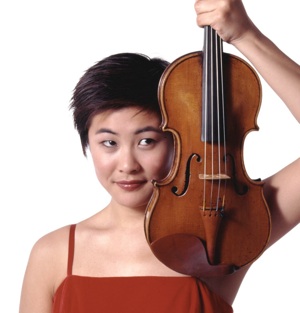Virtuosity and enigmas at Zellerbach
After five successful seasons, Joana Carneiro returned to rehearse and lead the Berkeley Symphony in “Enigma,” their opening concert. Zellerbach Hall on the UC Campus was nearly sold out to hear this popular conductor, and the after-concert dinner, a fund-raiser for education, was booked solid weeks out.
 They warmed up with the world premiere of Sea Shaped by British composer Oscar Bettison, a piece that attempts to recreate the feeling that we all come from the same salty essence, and may all be aligned to the rhythmic pulses of the sea.
They warmed up with the world premiere of Sea Shaped by British composer Oscar Bettison, a piece that attempts to recreate the feeling that we all come from the same salty essence, and may all be aligned to the rhythmic pulses of the sea.
The work itself was a little tame, more of an experiment in textures than a shaping of intent – but very nice textures! Clusters of cowbells, like something dropped down the stairs, made way for recurring string figures and the slow wheeze of horns. And its breath-like rhythms and pervasive tension made for the stuff of reverie.
“Sea Shaped is a kind of ritual,” explained Carneiro as she introduced the composer. Bettison added, “It was Paul Valery who said, ‘La mer, la mer, toujours recommencee.’ The sea, always beginning again. And it is really about the strings.”
This set the mood nicely for the headliner, world-famous violinist Jennifer Koh starring in Jean Sibelius’ Violin Concerto, a work that teeters between reckless beauty and towering loneliness.
I last heard Koh opening the Berkeley Symphony’s 2011 season, when she performed both Beethoven’s and John Adams’ Violin Concertos, a stunning feat of emotional suppleness and stamina.
At Thursday’s concert it was clear that this was a favorite of hers as she took us deep into the thoughts of Finland’s greatest composer. The opening combined a wintry angst with huge violin cadenzas. But then Koh turned to cue the symphony that she was almost done, and in a moment she became as accessible as she was stunning. And that presence and approachability were apparent throughout her delivery, particularly in her sumptuous low notes, penetrating even Zellerbach’s concrete caverns.
Sibelius wanted more than anything to be a concert violinist, and wrote his only concerto as a love song to a failed future. He did not have what it took to perform at that level and settled for composing. But what a concerto! All of that regret and beauty made for a combustible brew, with richly sarcastic chords, eye-popping runs and vibrant low notes from the underbelly. This was not the scald and sweetness of Brahms, but a bitter yearning that can bruise.
And after virtuosity, a puzzle.
 This concert was named for Edward Elgar’s Variations on an Original Theme, more often called the “Enigma Variations” because of his assertion that the theme points to an underlying puzzle or counter-theme, still unresolved to this day. Joana invited us to attempt a solution as we enjoyed the music, but those thoughts were soon pushed aside by the lovely variations.
This concert was named for Edward Elgar’s Variations on an Original Theme, more often called the “Enigma Variations” because of his assertion that the theme points to an underlying puzzle or counter-theme, still unresolved to this day. Joana invited us to attempt a solution as we enjoyed the music, but those thoughts were soon pushed aside by the lovely variations.
The orchestra sounded at their best in these difficult sketches, leaping from one temper to another. The richness of his harmonies when thinking of his wife, the rigorous exercises of a fellow musician and the bluster of a good friend all followed while hewing to an overall shape. Light-hearted youth, full-bodied viola, grace and whimsy all played an act, finishing with a penultimate movement that was generous and coloristic. Throughout, the Symphony was muscular and yielding in all the right places.
There are many likely answers to Elgar’s puzzle, including unstated counter-themes, four digits of pi, or the theme from Beethoven’s Pathétique. And though we can debate this puzzle, it raises another. Elgar was a mature man doing what he loved most. As he sat at the piano “painting” musical portraits for his wife, what is extraordinary is that one theme could create a language to describe their circle of friends. In effect, Elgar was describing all of humanity as variations on a theme! Like a religious epiphany, the depth of that perception is a loving lens into the commonality of humankind.
And like the parable of Plato’s cave, where we have been comfortable accepting shadows as substance, Elgar’s “puzzle” may be an invitation to squint into the source and see our kinship.
—Adam Broner
Photo, top, of Joana Carneiro by Dave Weiland; below, violinist Jennifer Koh.
